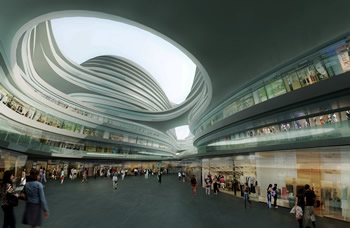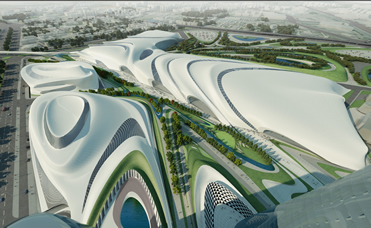
Zaha Hadid Architects, Galaxy – Soho China, Beijing
The Parametric City
Patrik Schumacher, London 2010
Published in: Zaha Hadid – Recent Projects, A.D.A. Edita, Tokyo 2010
Thesis: The cities of the future can only be sustainable if they become truly parametric.
Our technologically based world civilization has expanded its power of wealth creation to the point where it becomes its own barrier. We are finally compelled to recognize the finitude of our planet. Our world has shrunk to this single, fragile, shared “spaceship planet earth”. Every new enterprise must now involve an additional reflective loop about its potential ecological consequences.
Cities are a crucial conduit of our global consumption of energy, air and water. Buildings consume energy and pollute during their life cycle as well as during their fabrication and construction. The ecological sustainability of our civilization depends upon our ability to find more intelligent and light-footed ways to harness and utilize the finite resources of our natural environment. This necessity imposes a new constraint upon the design of our built environment, not only in terms of new technology and innovative engineering solutions, but also in terms of the architectural order and stylistic expression of the built environment. However, the imperative of energy saving must not imply that the shutters are coming down. The task is to create cities that sustainably adapt to the natural environment without arresting the progressive, developmental thrust of our civilization.
Cultural advancement has to continue. This is not only an end in itself but the sine qua non of our continued survival on spaceship earth. Continuous technological innovation is a necessary precondition for our ability to ascertain our ongoing ecological sustainability. Therefore the tightening of ecological constraints that impose themselves upon the design of cities must not constrain the vitality and productivity of the life processes they accommodate. Cities must continue to provide the living conditions that are favourable to innovative work. Thus before we can fully address the question of how to optimize our cities in terms of environmental engineering we must answer the question which urban patterns and architectural morphologies are most likely to vitalize and advance the productive life and communication processes everything else depends upon.
This latter question involves architecture’s enduring core competency and societal function, namely to order and frame societal communication via the innovative/adaptive design of the built environment. All social communication requires institutions. All institutions require architectural frames1.
The prevalent institutions and communication patterns of society have undergone momentous changes during the last 30 years. Social communication has been dynamized, differentiated and intensified. The static organizing principles of Fordist Mass Society - separation, specialization, and mass repetition - have been replaced by the dynamic principles of self-organization of the emerging Postfordist Network Society: variation, flexible specialization, and networking. Accordingly Modernist urbanism (zoning) and Modernist architecture (serial monotony) experienced a fatal crisis.
The inherent limitations of the linear models of expansion that characterized Fordism had become apparent both in terms of the ecological, the socio-economic, as well as the urban crises of the 1970s. The pertinent theoretical answer developed in the form of complexity theory analyzing and simulating self-regulating systems ranging from simple, homeostatic feedback mechanisms via organisms to evolving eco-systems. The same theoretical resources and computational techniques that allow meteorologists to reconstruct and predict the global weather system and scientists to speculate about the earth’s evolving climate are available to contemporary urbanists and architects in their effort to meet the challenges posed by the ongoing Postfordist socio-economic restructuring. The task is to project the growth and transformation of cities as a rule-based, largely self-regulating morphogenetic process. However, this emergent morphogenesis of the city is “designed” via computational processes (e.g. genetic algorithms) involving both generative processes as well as in-built selection criteria.
The emerging Network Society implies that the intensity of communication increases exponentially. Even while the use of the internet and mobile devices increases, the demand for face to face communication - mediated by architectural and urban spaces - increases too. That is why the solution cannot involve the shutting down of the urban porosity and urban flow. Postfordism requires new, more variegated, complex, and densely integrated patterns of spatial ordering that are inherently multivalent and adaptive. In retrospect Postmodernism (1980s) and Deconstructivism (1990s) might be understood as first groping steps in this direction. They have since been superseded - their partial insights and discoveries being preserved and elaborated - by a new powerful paradigm and style that promises to guide a new long wave of design research and innovation: Parametricism2.
Parametricism is gathering momentum to become the first new global, unified style that can and must replace Modernism as credible epochal style. Parametricism confronts both, the remaining vestiges of Modernist’s monotony, and the cacophony of the urban chaos that has sprung up in the wake of Modernism’s demise, with a complex, variegated order inspired by the self-organising processes of nature. The premise of Parametricism is that all urban and architectural elements must be parametrically malleable. Instead of assembling rigid and hermetic geometric figures - like all previous architectural styles - Parametricism brings malleable components into a dynamical play of mutual responsiveness as well as contextual adaptation. Key design processes are variation and correlation. Computationally, any property - positional, geometric, material - of any architectural element can be associated with - made the “cause” or “effect” of - any other property of any other element of the design. The designer invents and formulates correlations or rules akin to the laws of nature. Thus everything is potentially made to network and resonate with everything else. This should result in an overall intensification of relations that gives the urban field a performative density, informational richness, and cognitive coherence that makes for good legibility, easy navigation and thus quick, effective participation in a complex social arena where everybody’s ability to scan an ever-increasing simultaneity of events and to move through a rapid successions of communicative encounters constitutes the essential, contemporary form of the cultural advancement.
The ecological challenge referred to above is among the defining moments of our epoch. Its impact on contemporary architecture and urbanism is second only to the challenge posed by the dynamic and complexity of Postfordist Network Society. Indeed, the general paradigm of “eco-systems” applies to both, and is embraced as founding paradigm of Parametricism. The same design concepts, techniques and tools of Parametricism that allow contemporary architects to ramp up the communicative complexity of the built environment are also congenial to the agenda of optimizing architectural forms with respect to ecological performance criteria. Morphological output variables can be programmed to respond to environmental input parameters. For instance, a data-set like a sun exposure map that maps the radiation-intensities a facade is exposed to during a given time period can become the data-input for the adaptive modulation of a sun-shading system. As the system of shading elements wraps around the façade the spacing, shape and orientation of the individual elements gradually transform and adapt to the specific exposure conditions of their respective location on the façade. The result is a gradient, continuously changing façade pattern that optimizes sun-protection relative to light intake for each point on the façade. At the same time, this adaptive modulation gives the building an organic aesthetic that also makes the orientation of the building in the environment legible and thus facilitates the comprehension and navigation of the urban environment. The differentiated articulation of the façade contains and transmits information about its position rather than remaining indifferent and blind. The same principle of conspicuous, adaptive variation and correlation is being applied to the activity and event parameters of the urban life process. The disorientating, generic neutrality and monotony of Modernism gives way to the ecologically adaptive eloquence of Parametricism.

Zaha Hadid Architects, Galaxy – Soho China, Beijing
 - Copy.jpg)
Zaha Hadid Architects, Stone Towers, New Cairo

Zaha Hadid Architects, Expo City, Cairo
2 For a full statement of the meaning and merits of Parametricism see: Patrik Schumacher, Parametricism: A new global style for architecture and urban design, in Neil Leach (ed), AD Digital Cities, Architectural Design Vol 79, No 4, July/August 2009.